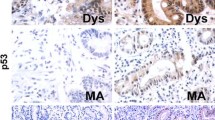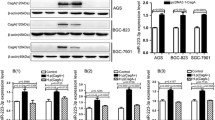Abstract
Background/aims
A proliferation-inducing ligand (APRIL, also known as TNFSF13, CD256) is a member of the tumor necrosis factor (TNF) superfamily and involved in a diverse set of diseases. In this work, we explored the potential associations and underlying mechanism in patients suffered from gastric cancer between the expression of APRIL and H. pylori infection.
Methods
We analyzed APRIL expression levels in 200 GC tissue samples by immunohistochemistry staining. H. pylori infection was detected by modified Giemsa staining. The biological effects of APRIL on human GC cells in vitro and in vivo were tested by CCK-8 assay, colony formation, flow cytometry detection, transwell migration assay, matrigel invasion assay, and tumor xenograft assay in animals.
Results
APRIL reactivity was positively correlated with H. pylori infection in vitro and vivo. It turned out that the decrease of miR-145 expression was dose-dependent and time-dependent on H. pylori infection and in consistent with APRIL expression. MiR-145 significantly attenuated the effect of H. pylori infection on APRIL gene expression in SGC7901 and BGC823 cell lines. Furthermore, APRIL overexpression promoted the proliferation, migration, invasion, and transfer of GC cells and decreased apoptosis, while APRIL knockdown suppressed these effects. We confirmed that APRIL activated the canonical NF-κB pathway through phosphorylation of AKT.
Conclusion
The expression of APRIL, which promoted the proliferation, migration, invasion, viability, and metastasis of GC cells, was upregulated in human H. pylori-infected GC through miR-145. Besides, APRIL-induced gastric tumorigenicity via activating NF-κB pathway. These results may provide a framework for the deeper analysis of APRIL in GC risk and prognosis.






Similar content being viewed by others
References
Bartel DP (2004) MicroRNAs_genomics, biogenesis, mechanism, and function. Cell 116:281–297
Bertuccio P, Chatenoud L, Levi F, Praud D, Ferlay J, Negri E, Malvezzi M, La Vecchia C (2009) Recent patterns in gastric cancer: a global overview. Int J Cancer 125:666–673
Calin GA, Croce CM (2006) MicroRNA signatures in human cancers. Nat Rev Cancer 6:857–866
Castigli E, Scott S, Dedeoglu F, Bryce P, Jabara H, Bhan AK, Mizoguchi E, Geha RS (2004) Impaired IgA class switching in APRIL-deficient mice. ProcNatlAcadSci U S A 101:3903–3908
Cho WC, Chow AS, Au JS (2009) Restoration of tumour suppressor hsa-miR-145 inhibits cancer cell growth in lung adenocarcinoma patients with epidermal growth factor receptor mutation. Eur J Cancer 45:2196–2206
Correa P (2004) Is gastric cancer preventable? Gut 53:1217–1219
Crew KD, Neugut AI (2006) Epidemiology of gastric cancer. World J Gastroenterol 12:354–362
Davis PA, Sano T (2001) The difference in gastric cancer between Japan, USA and Europe_What are the facts_What are the suggestions. Crit Rev OncolHematol 40:77–94
Deshayes F, Lapree G, Portier A, Richard Y, Pencalet P, Mahieu-Caputo D, Horellou P, Tsapis A (2004) Abnormal production of the TNF-homologue APRIL increases the proliferation of human malignant glioblastoma cell lines via a specific receptor. Oncogene 23:3005–3012
Dillon SR, Gross JA, Ansell SM, Novak AJ (2006) An APRIL to remember: novel TNF ligands as therapeutic targets. Nat Rev Drug Discov 5:235–246
Eid R, Moss SF (2002) Helicobacter pylori infection and the development of gastric cancer. N Engl J Med 346:65–67
Ferlay J, Soerjomataram I, Dikshit R, Eser S, Mathers C, Rebelo M, Parkin DM, Forman D, Bray F (2015) Cancer incidence and mortality worldwide: sources, methods and major patterns in GLOBOCAN 2012. Int J Cancer 136:E359–E386
Gao P, Xing A-Y, Zhou G-Y, Zhang T-G, Zhang J-P, Gao C, Li H, Shi D-B (2013) The molecular mechanism of microRNA-145 to suppress invasion–metastasis cascade in gastric cancer. Oncogene 32(4):491–501
Hahne M, Kataoka T, Schröter M, Hofmann K, Irmler M, Bodmer JL, Schneider P, Bodmer JL, Schneider P, Bornand T, Holler N, French LE, Sordat B, Rimoldi D, Tschopp J (1998) APRIL, a new ligand of the tumor necrosis factor family, stimulates tumor cell growth. J Exp Med 188:1185–1190
IARC Working Group (2006) Schistosomes, liver flukes and Helicobacter pylori IARC Working Group on the Evaluation of Carcinogenic Risks to Humans. Lyon, 7–14 June 1994. IARC MonogrEvalCarcinog Risks Hum 61:1–241
Ichimi T, Enokida H, Okuno Y, Kunimoto R, Chiyomaru T, Kawamoto K, Kawahara K, Toki K, Kawakami K, Nishiyama K, Tsujimoto G, Nakagawa M, Seki N (2009) Identification of novel microRNA targets based on microRNA signatures in bladder cancer. Int J Cancer 125(2):345–352
Jonkers DSE, de Bruine A, Arends JW, Stockbrügger R (1997) Evaluation of immunohistochemistry for the detection of Helicobacter pylori in gastric mucosal biopsies. J Infect 35:149–154
Kalled SL, Ambrose C, Hsu YM (2005) The biochemistry and biology of BAFF, APRIL and their receptors. CurrDirAutoimmun 8:206–242
Kloosterman WP, Plasterk RHA (2006) The diverse functions of microRNAs in animal development and disease. Dev Cell 11(4):441–450
Kang SY, Han JH, Ahn MS, Lee HW, Jeong SH, Park JS, Cho YK, Han SU, Kim YB, Kim JH, Sheen SS, Lim HY, Choi JH (2012) Helicobacter pylori infection as an independent prognostic factor for locally advanced gastric cancer patients treated with adjuvant chemotherapy after curative resection. Int J Cancer 130:948–958
Kern CCJ, Billard C, Tang R, Rouillard D, Stenou V, Defrance T, Ajchenbaum-Cymbalista F, Slimonin PY, Feldblum S, Kolb JP (2015) Involvement of BAFF andAPRILin the resistance to apoptosis of B-CLL through an autocrine pathway. Blood 103:679–688
Kononen JBL, Kallioniemi A, Bärlund M, Schraml P, Leighton S, Torhorst J, Mihatsch MJ, Sauter G, Kallioniemi OP (1998) Tissue microarrays for high-throughput molecular profiling of tumor specimens. Nat Med 4:844–847
Li Z, Chen J, Chan KW, Qiao L, Wong BC (2011) A possible role of cIAP2 in Helicobacter pylori-associated gastric cancer. CancerLett 313:192–200
Lin DC, Lin JB, Chen Z, Chen R, Wan CY, Lin SW, Ruan QS, Li HY, Wu SY (2017) Independent and combined effects of environmental factors and miR-126, miR-143 and miR-145 on the risk of coronary heart disease. J Geriatri Cardiol 14:688–695
Litinskiy MB, Nardelli B, Hilbert DM, He B, Schaffer A, Casali P, Cerutti A (2002) DCs induce CD40-independent immunoglobulin class switching through BLyS and APRIL. Nat Immunol 3:822–829
McColl KE (2010) Clinical practice. Helicobacter pylori infection. N Engl J Med 362:1597–1604
Moreaux J, Cremer FW, Reme T, Raab M, Mahtouk K, Kaukel P, Pantesco V, De Vos J, Jourdan E, Jauch A, Legouffe E, Moos M, Fiol G, Goldschmidt H, Rossi JF, Hose D, Klein B (2005) The level of TACI gene expression in myeloma cells is associated with a signature of microenvironment dependence versus a plasmablastic signature. Blood 106:1021–1030
Ni SZ, Cao HY, Chen Z, Zhu Y, Xu ZK (2012) siRNA interference with a proliferation-inducing ligand gene in the Sgr-7901 gastric carcinoma cell line. Asian Pac J Cancer Prev 13:1511–1514
Nishiyama M, Eguchi H (2009) Pharmacokinetics and pharmacogenomics in gastric cancer chemotherapy. Adv Drug Deliv Rev 61:402–407
Novak AJ, Bram RJ, Kay NE, Jelinek DF (2002) Aberrant expression of B lymphocyte stimulator by B chronic lymphocytic leukemia cells: a mechanism for survival. Blood 100:2973–2979
Parkin DM (2006) The global health burden of infection-associated cancers in the year 2002. Int J Cancer 118:3030–3044
Plummer M, Franceschi S, Vignat J, Forman D, de Martel C (2015) Global burden of gastric cancer attributable to Helicobacter pylori. Int J Cancer 136:487–490
Sachdeva M, Mo Y-Y (2010) MicroRNA-145 Suppresses cell invasion and metastasis by directly targeting Mucin 1. Cancer Res 70 (1):378–387
Schepeler T, Reinert JT, Ostenfeld MS, Christensen LL, Silahtaroglu AN, Dyrskjøt L, Wiuf C, Sørensen FJ, Kruhøffer M, Laurberg S, Kauppinen S, Ørntoft TF, Andersen CL (2008) Diagnostic and prognostic microRNAs in stage II colon cancer. Cancer Res 68(15):6416–6424
Schwaller JSP, Mhawech-Fauceglia P, McKee T, Myit S, Matthes T, Tschopp J, Donze O, Le Gal FA, Huard B (2015) Neutrophil-derived APRIL concentrated in tumor lesions by proteoglycans correlates with human B cell lymphoma aggressiveness. Blood 109:331–338
Siegel R, Naishadham D, Jemal A (2013) Cancer statistics, 2013. CA Cancer J Clin 63:11–30
Torre LA, Bray F, Siegel RL, Ferlay J, Lortet-Tieulent J, Jemal A (2015) Global cancer statistics, 2012. CA Cancer J Clin 65:87–108
Torres J, Correa P, Ferreccio C, Hernandez-Suarez G, Herrero R, Cavazza-Porro M, Dominguez R, Morgan D (2013) Gastric cancer incidence and mortality is associated with altitude in the mountainous regions of Pacific Latin America. Cancer Causes Control 24:249–256
Wang G, Wang F, Ding W, Wang J, Jing R, Li H, Wang X, Wang Y, Ju S, Wang H (2013) APRIL induces tumorigenesis and metastasis of colorectal cancer cells via activation of the PI3K/Akt pathway. PLoS ONE 8:e55298
Wong BCLS, Wong WM, Chen JS, Zheng TT, Feng RE, Lai KC, Hu WH, Yuen ST, Leung SY, Fong DY, Ho J, Ching CK, Chen JS, China Gastric Cancer Study Group (2004) Helicobacter pylori eradication to prevent gastric cancer in a high-risk region of China. JAMA 291:187–194
Wroblewski LE, Peek RM Jr, Wilson KT (2010) Helicobacter pylori and gastric cancer: factors that modulate disease risk. ClinMicrobiol Rev 23:713–739
Wu H, Xiao Z, Wang K, Liu W, Hao Q (2013) MiR-145 is downregulated in human ovarian cancer and modulates cell growth and invasion by targeting p70S6K1 and MUC1. BiochemBiophys Res Commun 441:693–700
Xi JJ (2013) MicroRNAs in cancer. Cancer Treat Res 158:119–137
Zhang B, Pan X, Cobb GP, Anderson TA (2007) microRNAs as oncogenes and tumor suppressors. Dev Biol 302:1–12
Zhao Y, Srivastava D (2007) A developmental view of microRNA function. Trends Biochem Sci 32(4):189–197
Zhi X, Tao J, Xiang G, Cao H, Liu Z, Yang K, Lv C, Ni S (2015) APRIL induces cisplatin resistance in gastric cancer cells via activation of the NF-kappaB pathway. Cell PhysiolBiochem 35:571–585
Acknowledgements
This work was partially supported by the National Natural Science Foundation of China (81272712, 30901421), the National Natural Science Foundation Project of International Cooperation(NSFC-NIH, 812111519), the Program for Development of Innovative Research Team in the First Affiliated Hospital of NJMU, the Priority Academic Program Development of Jiangsu Higher Education Institutions (PAPD, JX10231801), and the translational research of early diagnosis and comprehensive treatment in pancreatic cancer (The research Special Fund For public welfare industry of health, 201202007).
Author information
Authors and Affiliations
Corresponding author
Ethics declarations
Conflict of interest
The authors declared that they have no financial or non-financial competing interest.
Additional information
Publisher's Note
Springer Nature remains neutral with regard to jurisdictional claims in published maps and institutional affiliations.
Rights and permissions
About this article
Cite this article
Zhang, Q., Ni, Y., Zhi, X. et al. Involvement of APRIL in Helicobacter pylori-related gastric cancer. J Cancer Res Clin Oncol 147, 1685–1697 (2021). https://doi.org/10.1007/s00432-021-03574-x
Received:
Accepted:
Published:
Issue Date:
DOI: https://doi.org/10.1007/s00432-021-03574-x




